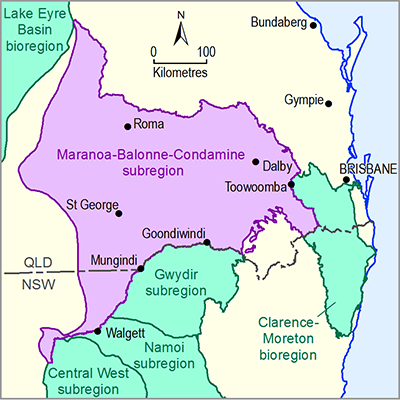Regional changes in surface water and groundwater flows due to additional coal resource development could potentially lead to changes in the quality of surface water and groundwater. Although water quality changes were not modelled explicitly as part of this BA, the implications for water quality in the Maranoa-Balonne-Condamine subregion are considered in this section in light of the modelled hydrological changes due to the additional coal resource development.
Relevant factors for assessing the potential for changes in regional groundwater and surface water quality from the two additional coal resource developments in the Maranoa-Balonne-Condamine subregion are:
- New Acland Coal Mine Stage 3:
- a proposed expansion of the existing New Acland open-cut mine, which will increase production from 4.8 to 7.5 Mt/y of thermal coal (New Hope Group, 2012, 2014). Approximately 10% of the New Acland mining lease area is mined at any one time, with ongoing rehabilitation to ensure the land is returned to a commercially viable agricultural state (EPA, 2006; New Hope Group, 2013).
- water demand is projected to increase from 1370 to 3300 ML/y (Psi-Delta, 2010; New Hope Group, 2014). Mine-affected water is sourced from overland flow as part of the mine’s zero discharge requirements. Other water sources include up to 5550 ML/y from the Toowoomba Regional Council Wetella Wastewater Reclamation Facility (WWRF) and 1412 ML/y of licensed groundwater extractions (New Hope Group, 2014).
- surface water runoff from disturbed and mine-affected areas will be captured and treated before potential release off-site. Controlled releases during periods of extended rainfall can be made to Lagoon Creek, based on the salinity of the released water and the flow in the receiving waters (New Hope Group, 2014). Surface water runoff from undisturbed areas will be diverted away and released directly into adjacent waterways.
- The Range coal mine:
- a proposed new open-cut coal mine, which is expected to produce 5 to 7 Mt/y of coal (DEHP, 2013). Approximately 8 million cubic metres of topsoil will be removed from three open-cut pits, which will be used for progressive rehabilitation.
- water demand is projected to be 1350 to 2868 ML/y (DEHP, 2013). Capture, storage and reuse of mine-affected water will be managed by mine water dams, including sediment dams, to treat water prior to release or potential release off-site. Other potential water sources include the proposed SunWater Wolleebee Creek to Glebe Weir pipeline or co‑produced water (DEHP, 2013).
- surface water runoff from disturbed sites will be captured and used to meet mine water needs as part of zero discharge requirements. Surface water runoff from undisturbed areas will be diverted away and released directly into adjacent waterways (DEHP, 2013).
In the following sections, the causal pathways that could potentially lead to regional impacts on water quality are identified and the risk of impact is assessed qualitatively. The extent of influence and existing regulation and management practices are used to inform the assessment of risk.

Product Finalisation date
- 3.1 Overview
- 3.2 Methods
- 3.3 Potential hydrological changes
- 3.4 Impacts on and risks to landscape classes
- 3.4.1 Overview
- 3.4.2 Landscape classes that are unlikely to be impacted
- 3.4.3 'Floodplain or lowland riverine (including non-GAB GDEs)' landscape group
- 3.4.4 'GAB GDEs (riverine, springs, floodplain or non-floodplain)' landscape group
- 3.4.5 'Non-floodplain or upland riverine (including non-GAB GDEs)' landscape group
- 3.4.6 'Human-modified' landscape group
- References
- Datasets
- 3.5 Impacts on and risks to water-dependent assets
- 3.6 Commentary for coal resource developments that are not modelled
- 3.7 Conclusion
- Citation
- Acknowledgements
- Contributors to the Technical Programme
- About this technical product
